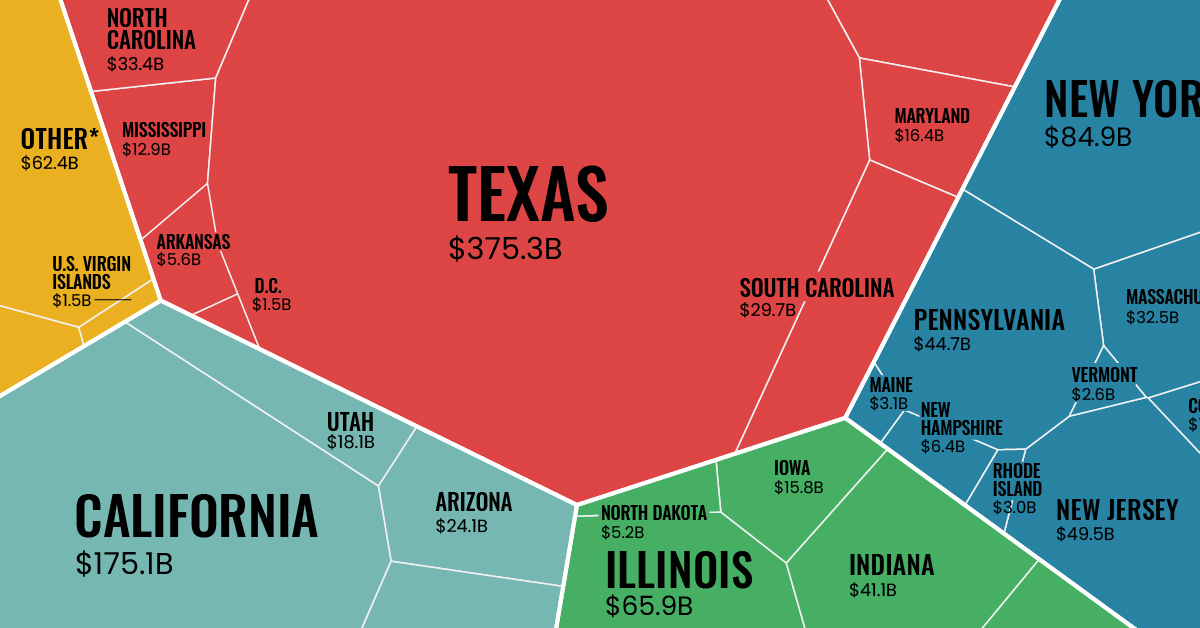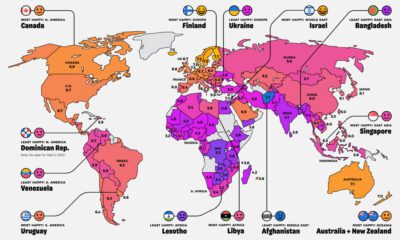Markets
Made in America: Goods Exports by State

Made in America: Goods Exports by State
After China, the U.S. is the next largest exporter of goods in the world, shipping out $1.8 trillion worth of goods in 2021—an increase of 23% over the previous year.
Of course, that massive number doesn’t tell the whole story. The U.S. economy is multifaceted, with varying levels of trade activity taking place all across the nation.
Using the latest data on international trade from the U.S. Census Bureau and the U.S. Bureau of Economic Analysis, we’ve visualized the value of America’s goods exports by state.
Top 10 Exporter States
Here are the top 10 American states that exported the highest dollar value worth of goods during 2021. Combined, these export-leading states represent 59.4% of the nation’s total exports.
| Rank | State | Total Exports Value | % share |
|---|---|---|---|
| #1 | Texas | $375.3 billion | 21.4% |
| #2 | California | $175.1 billion | 10.0% |
| #3 | New York | $84.9 billion | 4.8% |
| #4 | Louisiana | $76.8 billion | 4.4% |
| #5 | Illinois | $65.9 billion | 3.8% |
| #6 | Michigan | $55.5 billion | 3.2% |
| #7 | Florida | $55.5 billion | 3.2% |
| #8 | Washington | $53.6 billion | 3.1% |
| #9 | Ohio | $50.4 billion | 2.9% |
| #10 | New Jersey | $49.5 billion | 2.8% |
| Top 10 States | $1.04 trillion | 59.4% |
Texas has been the top exporting state in the U.S. for an incredible 20 years in a row.
Last year, Texas exported $375 billion worth of goods, which is more than California ($175 billion), New York ($85 billion), and Louisiana ($77 billion) combined. The state’s largest manufacturing export category is petroleum and coal products, but it’s also important to mention that Texas led the nation in tech exports for the ninth straight year.
California was the second highest exporter of goods in 2021 with a total value of $175 billion, an increase of 12% from the previous year. The state’s main export by value was computer and electronic product manufacturing, representing 17.8% of the total U.S. exports of that industry. California was also second among all states in exports of machinery manufacturing, accounting for 13.9% of the U.S. total.
What Type of Goods are Exported?
Here is a breakdown of the biggest U.S. export categories by value in 2021.
| Rank | Product Group | Annual Export Value (2021) | Share of Total Exports |
|---|---|---|---|
| 1 | Mineral fuels including oil | $239.8 billion | 13.7% |
| 2 | Machinery including computers | $209.3 billion | 11.9% |
| 3 | Electrical machinery, equipment | $185.4 billion | 10.6% |
| 4 | Vehicles | $122.2 billion | 7.0% |
| 5 | Optical, technical, medical apparatus | $91.7 billion | 5.2% |
| 6 | Aircraft, spacecraft | $89.1 billion | 5.1% |
| 7 | Gems, precious metals | $82.3 billion | 4.7% |
| 8 | Pharmaceuticals | $78 billion | 4.4% |
| 9 | Plastics, plastic articles | $74.3 billion | 4.2% |
| 10 | Organic chemicals | $42.9 billion | 2.4% |
These top 10 export categories alone represent almost 70% of America’s total exports.
The biggest grower among this list is mineral fuels, up by 59% from last year. Pharmaceuticals saw the second biggest one-year increase (45%).
Top 10 U.S. Exports by Country of Destination
So who is buying “Made in America” products?
Unsurprisingly, neighboring countries Canada (17.5%) and Mexico (15.8%) are the two biggest buyers of American goods. Together, they purchase one-third of American exports.
| Rank | Destination Country | Share of U.S. Goods Exports |
|---|---|---|
| 1 | 🇨🇦 Canada | 17.5% |
| 2 | 🇲🇽 Mexico | 15.8% |
| 3 | 🇨🇳 China | 8.6% |
| 4 | 🇯🇵 Japan | 4.3% |
| 5 | 🇰🇷 South Korea | 3.7% |
| 6 | 🇩🇪 Germany | 3.7% |
| 7 | 🇬🇧 United Kingdom | 3.5% |
| 8 | 🇳🇱 Netherlands | 3.1% |
| 9 | 🇧🇷 Brazil | 2.7% |
| 10 | 🇮🇳 India | 2.3% |
Three Asian countries round out the top five list: China (8.6%), Japan (4.3%), and South Korea (3.7%). Together, the top five countries account for around half of all goods exports.
Markets
The European Stock Market: Attractive Valuations Offer Opportunities
On average, the European stock market has valuations that are nearly 50% lower than U.S. valuations. But how can you access the market?

European Stock Market: Attractive Valuations Offer Opportunities
Europe is known for some established brands, from L’Oréal to Louis Vuitton. However, the European stock market offers additional opportunities that may be lesser known.
The above infographic, sponsored by STOXX, outlines why investors may want to consider European stocks.
Attractive Valuations
Compared to most North American and Asian markets, European stocks offer lower or comparable valuations.
| Index | Price-to-Earnings Ratio | Price-to-Book Ratio |
|---|---|---|
| EURO STOXX 50 | 14.9 | 2.2 |
| STOXX Europe 600 | 14.4 | 2 |
| U.S. | 25.9 | 4.7 |
| Canada | 16.1 | 1.8 |
| Japan | 15.4 | 1.6 |
| Asia Pacific ex. China | 17.1 | 1.8 |
Data as of February 29, 2024. See graphic for full index names. Ratios based on trailing 12 month financials. The price to earnings ratio excludes companies with negative earnings.
On average, European valuations are nearly 50% lower than U.S. valuations, potentially offering an affordable entry point for investors.
Research also shows that lower price ratios have historically led to higher long-term returns.
Market Movements Not Closely Connected
Over the last decade, the European stock market had low-to-moderate correlation with North American and Asian equities.
The below chart shows correlations from February 2014 to February 2024. A value closer to zero indicates low correlation, while a value of one would indicate that two regions are moving in perfect unison.
| EURO STOXX 50 | STOXX EUROPE 600 | U.S. | Canada | Japan | Asia Pacific ex. China |
|
|---|---|---|---|---|---|---|
| EURO STOXX 50 | 1.00 | 0.97 | 0.55 | 0.67 | 0.24 | 0.43 |
| STOXX EUROPE 600 | 1.00 | 0.56 | 0.71 | 0.28 | 0.48 | |
| U.S. | 1.00 | 0.73 | 0.12 | 0.25 | ||
| Canada | 1.00 | 0.22 | 0.40 | |||
| Japan | 1.00 | 0.88 | ||||
| Asia Pacific ex. China | 1.00 |
Data is based on daily USD returns.
European equities had relatively independent market movements from North American and Asian markets. One contributing factor could be the differing sector weights in each market. For instance, technology makes up a quarter of the U.S. market, but health care and industrials dominate the broader European market.
Ultimately, European equities can enhance portfolio diversification and have the potential to mitigate risk for investors.
Tracking the Market
For investors interested in European equities, STOXX offers a variety of flagship indices:
| Index | Description | Market Cap |
|---|---|---|
| STOXX Europe 600 | Pan-regional, broad market | €10.5T |
| STOXX Developed Europe | Pan-regional, broad-market | €9.9T |
| STOXX Europe 600 ESG-X | Pan-regional, broad market, sustainability focus | €9.7T |
| STOXX Europe 50 | Pan-regional, blue-chip | €5.1T |
| EURO STOXX 50 | Eurozone, blue-chip | €3.5T |
Data is as of February 29, 2024. Market cap is free float, which represents the shares that are readily available for public trading on stock exchanges.
The EURO STOXX 50 tracks the Eurozone’s biggest and most traded companies. It also underlies one of the world’s largest ranges of ETFs and mutual funds. As of November 2023, there were €27.3 billion in ETFs and €23.5B in mutual fund assets under management tracking the index.
“For the past 25 years, the EURO STOXX 50 has served as an accurate, reliable and tradable representation of the Eurozone equity market.”
— Axel Lomholt, General Manager at STOXX
Partnering with STOXX to Track the European Stock Market
Are you interested in European equities? STOXX can be a valuable partner:
- Comprehensive, liquid and investable ecosystem
- European heritage, global reach
- Highly sophisticated customization capabilities
- Open architecture approach to using data
- Close partnerships with clients
- Part of ISS STOXX and Deutsche Börse Group
With a full suite of indices, STOXX can help you benchmark against the European stock market.

Learn how STOXX’s European indices offer liquid and effective market access.

-

 Economy3 days ago
Economy3 days agoEconomic Growth Forecasts for G7 and BRICS Countries in 2024
The IMF has released its economic growth forecasts for 2024. How do the G7 and BRICS countries compare?
-

 Markets2 weeks ago
Markets2 weeks agoU.S. Debt Interest Payments Reach $1 Trillion
U.S. debt interest payments have surged past the $1 trillion dollar mark, amid high interest rates and an ever-expanding debt burden.
-

 United States2 weeks ago
United States2 weeks agoRanked: The Largest U.S. Corporations by Number of Employees
We visualized the top U.S. companies by employees, revealing the massive scale of retailers like Walmart, Target, and Home Depot.
-

 Markets2 weeks ago
Markets2 weeks agoThe Top 10 States by Real GDP Growth in 2023
This graphic shows the states with the highest real GDP growth rate in 2023, largely propelled by the oil and gas boom.
-

 Markets2 weeks ago
Markets2 weeks agoRanked: The World’s Top Flight Routes, by Revenue
In this graphic, we show the highest earning flight routes globally as air travel continued to rebound in 2023.
-

 Markets3 weeks ago
Markets3 weeks agoRanked: The Most Valuable Housing Markets in America
The U.S. residential real estate market is worth a staggering $47.5 trillion. Here are the most valuable housing markets in the country.
-

 Debt1 week ago
Debt1 week agoHow Debt-to-GDP Ratios Have Changed Since 2000
-

 Markets2 weeks ago
Markets2 weeks agoRanked: The World’s Top Flight Routes, by Revenue
-

 Demographics2 weeks ago
Demographics2 weeks agoPopulation Projections: The World’s 6 Largest Countries in 2075
-

 Markets2 weeks ago
Markets2 weeks agoThe Top 10 States by Real GDP Growth in 2023
-

 Demographics2 weeks ago
Demographics2 weeks agoThe Smallest Gender Wage Gaps in OECD Countries
-

 Economy2 weeks ago
Economy2 weeks agoWhere U.S. Inflation Hit the Hardest in March 2024
-

 Green2 weeks ago
Green2 weeks agoTop Countries By Forest Growth Since 2001
-

 United States2 weeks ago
United States2 weeks agoRanked: The Largest U.S. Corporations by Number of Employees















